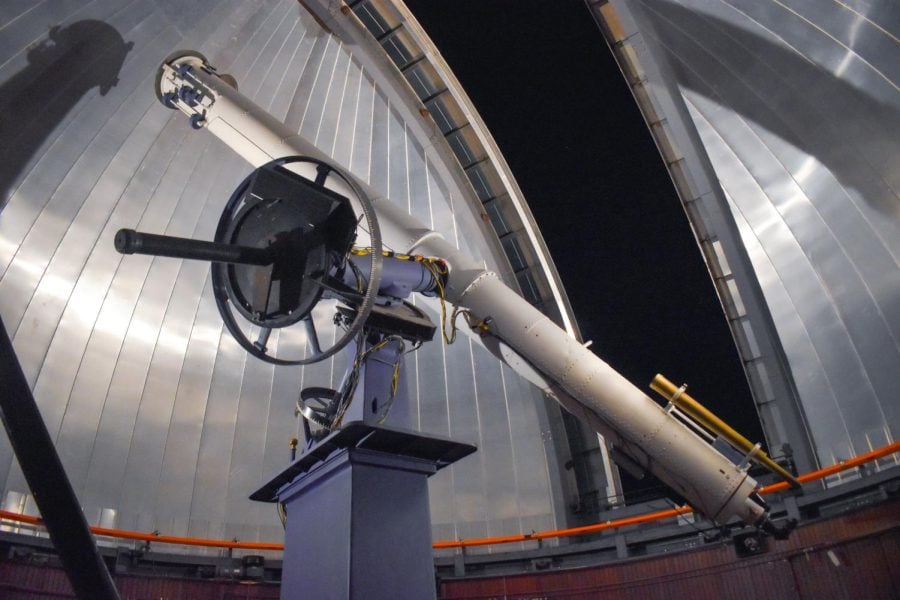Dearborn Observatory reopens to public after two-year closure
Jacob Wendler/The Daily Northwestern
The 18 1/2-inch lens in Dearborn Observatory’s refracting telescope was the largest in the world when it was built in the 19th century.
April 5, 2022
After going dark for two years, Dearborn Observatory will once again give amateur astronomers the opportunity to see space’s brightest stars in detail.
The observatory reopened to the public Friday night after shutting down in March 2020 because of the pandemic and remaining closed throughout this past fall and winter for construction.
According to astronomy and physics Prof. Michael Smutko, observatory director, Dearborn is pursuing a “soft reopening” with public tours available on a reservation-only basis through June.
Beverly Lowell, a fourth-year astronomy and physics graduate student, said she enjoys connecting with the community as a host and tour guide at the observatory, which she has been doing since 2019.
“When someone sees Saturn or Jupiter through the telescope for the first time, even if they know what it looks like, seeing it with their own eyes is so special,” Lowell said. “The look on their face is priceless.”
Students and faculty in the physics and astronomy department often use the observatory, and classes like Astronomy 120: Highlights of Astronomy and Astronomy 321: Observational Astrophysics use the Dearborn telescope for observing sessions.
Beginning this summer, Smutko said the observatory plans to open for walk-in tours, which were held weekly before the pandemic and attracted over 1500 visitors each year.
Undergraduate and graduate students host tours in all weather conditions, although visitors are advised to dress appropriately because the dome does not have heat or air conditioning.
Weinberg junior Jay Zou, who began hosting tours at the observatory in 2020 and now studies physics and astronomy, said he was inspired to get involved with Dearborn after participating in astronomy research in Colorado as a high-school student.
“I really love mentorship and teaching and just the thought of being able to potentially inspire young scientists from a diverse set of backgrounds,” Zou said. “I feel like it’s something that every scientist should do — you don’t just do science, but you also do outreach to the community.”
The tour experience includes a brief overview of Dearborn’s history and a chance to look through the observatory’s refracting telescope, which features an 18 1/2-inch lens, which was the largest in the world from 1862 to 1868.
The lens, built in Massachusetts for the University of Mississippi in the early 1860s, was first used by the University of Chicago in 1866 when the Civil War prevented it from being transported to Mississippi. After the original University of Chicago went bankrupt following the Great Chicago Fire of 1871, the telescope landed at NU in 1887, and it was originally housed at the modern-day site of the Technological Institute.
To make room for the Technological Institute, in 1939 the observatory was moved to its current location over the course of three months. The observatory’s current dome was installed in 1997 and refurbished the following year.
In its 135 years at NU, Dearborn has been the site of research on UFOs and continental drift as well as facilitated the discovery of over 100 binary stars and the first white dwarf.
Smutko said the upcoming total lunar eclipse that will be visible from Chicago on the evening of May 15 is an astronomical event community members can anticipate. The observatory plans to host an outdoor observing session for the event depending on weather and visibility, he said.
The observatory offers free tours every Friday night at 9 p.m. and 10 p.m. and members of the public can make reservations on the observatory’s website. While the observatory has already reached capacity for April tours, NU students, faculty and members of the community at large can make reservations for May and June.
“People can stay home in Google Images on the computer from Hubble Space Telescope and things like that,” Smutko said. “But coming and looking through an actual telescope is something that actually most of our visitors have never done, so we’re happy to give them the opportunity to do that.”
Email: jacobwendler2025@u.northwestern.edu
Twitter: @jacob.wendler
Related Stories:
— The Weekly Podcast: Out of this world
— Frozen dome at Dearborn Observatory doesn’t deter eclipse watch party
— NU astrophysicists trace locations of intense radio blasts to galaxies’ spiral arms



